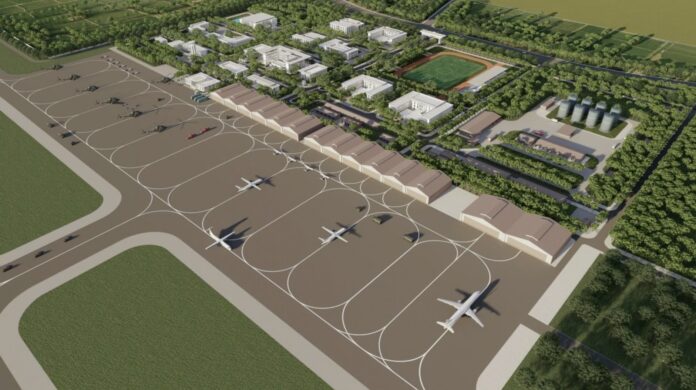
Gia Binh Airport has a capacity of 5 million passengers and 250,000 tons of cargo annually. Graphic illustration: VGP
Deputy Prime Minister Tran Hong Ha chaired a meeting of the Task Force on investing in the road connecting Gia Binh Airport with the capital city of Hanoi and constructing a logistics center in the airport area.
According to the Ministry of Construction, the Ministry has approved the addition of Gia Binh International Airport to the master plan for the development of the national airport and airfield system; detailed planning of Gia Binh International Airport; and adjustment and supplementation of Gia Binh inland port into the development planning of the inland port system.
Hanoi People’s Committee and Bac Ninh Provincial People’s Committee are preparing to invest in the road sections connecting Gia Binh Airport to the capital.
Vice Chairman of the Hanoi People’s Committee, Duong Duc Tuan, said that the section passing through Hanoi is about 14 km long, with a total investment of about VND 42,451 billion. The first component project involves compensation, support for resettlement, and site clearance on Hanoi’s territory within the boundary line of the road using the city’s public investment capital, with a total investment of about VND 8,115 billion. The city budget will cover the entire cost of site clearance and will not be included in the construction-transfer (BT) contract value of the second component project.
The second component project involves investing in the construction of the road connecting Gia Binh Airport to Hanoi through a public-private partnership (PPP) in the form of a BT contract, with a total investment of about VND 34,336 billion.
Regarding the section in Bac Ninh province, Chairman of the Provincial People’s Committee of Bac Ninh, Vuong Quoc Tuan, said that to maximize the efficiency of the airport after completion and improve connectivity with neighboring provinces, the Provincial People’s Committee of Bac Ninh proposed extending the road connecting Gia Binh Airport to Hanoi (about 22.9 km long) to Kênh Vàng Bridge to Hai Duong province (about 8.7 km long). Thus, the section passing through Bac Ninh province will be about 31.6 km long with a cross-section of 120 m.
The estimated investment cost in Bac Ninh province is about VND 40,300 billion, under a BT contract. Of this, the compensation cost for site clearance for the entire route within the 120 m wide road is estimated at VND 11,000 billion (the section from Gia Binh Airport to Hanoi is about VND 9,000 billion, and from Gia Binh Airport to Kênh Vàng Bridge is VND 2,000 billion). The investment cost for constructing the road connecting Gia Binh Airport to Hanoi and from Gia Binh Airport to Kênh Vàng Bridge is estimated at VND 29,300 billion.
Deputy Minister of Construction, Pham Minh Ha, suggested that the two localities could agree to implement a common BT project, but divide it into two component projects to ensure initiative, responsibility, and smooth implementation. He also proposed that they develop a detailed plan for implementation and set milestones (including decisions on investment policies, project approval, technical design approval, commencement, and completion) to ensure feasibility.
Concluding the meeting, Deputy Prime Minister Tran Hong Ha emphasized the urgency of investing in the construction of the connection between Gia Binh Airport and the capital, in tandem with the progress of the airport. Therefore, Hanoi and Bac Ninh have the authority to select investors with sufficient capacity to ensure efficient investment, technical design, unit prices, and norms to prevent loopholes, waste, and losses.
The Deputy Prime Minister agreed to separate site clearance into a separate project to be implemented ahead of time. He requested that the two localities take responsibility for the data and implement it according to the approved orientation and urgently establish and approve adjustments to the planning within their competence, such as provincial planning, master planning, and divisional planning.
Previously, the Ministry of Construction approved adjustments to the planning of Gia Binh International Airport for the period of 2021-2030, with a vision towards 2050. Accordingly, the passenger terminal will have a capacity of about 5 million passengers per year in the first phase from 2021 to 2030.
The Luxe Life: 5 Reasons Why You Shouldn’t Miss Out on The Pathway
In the vibrant landscape of Sam Son’s urban development, The Pathway residential complex is poised to emerge as a new landmark. For those seeking a quality second home or a solid investment opportunity, the recently launched apartments in Towers P2 and P3 of The Pathway present the perfect solution.
“Cienco4 Barred from Bidding in Ha Nam Province Due to Document Forgery in University Project”
Cienco 4 has established itself as a key player in major infrastructure projects across Vietnam. With a proven track record in large-scale developments, the company has been instrumental in shaping some of the nation’s most significant transportation hubs. Their expertise and involvement can be witnessed in the Quang Tri Airport, a 5.8-trillion VND project, as well as the prestigious Long Thanh Airport, where they undertook Package 4.6, valued at 8.1 trillion VND. Additionally, their portfolio includes the Le Van Luong – Hanoi’s Ring Road 3 tunnel, further showcasing their capabilities in delivering complex and vital infrastructure projects.
“Don’t Let Your Money Sleep”: Shark Truong Ly Hoang Phi’s Practical Financial Strategies
In today’s ever-changing economic landscape, optimizing cash flow is no longer a choice but a survival skill for individuals and businesses alike. In Episode 6 of the “Unlocking Passive Income” podcast series, Shark Truong Ly Hoang Phi delivers candid and practical insights on how to manage personal finances with flexibility, even with the smallest amounts of money.





















